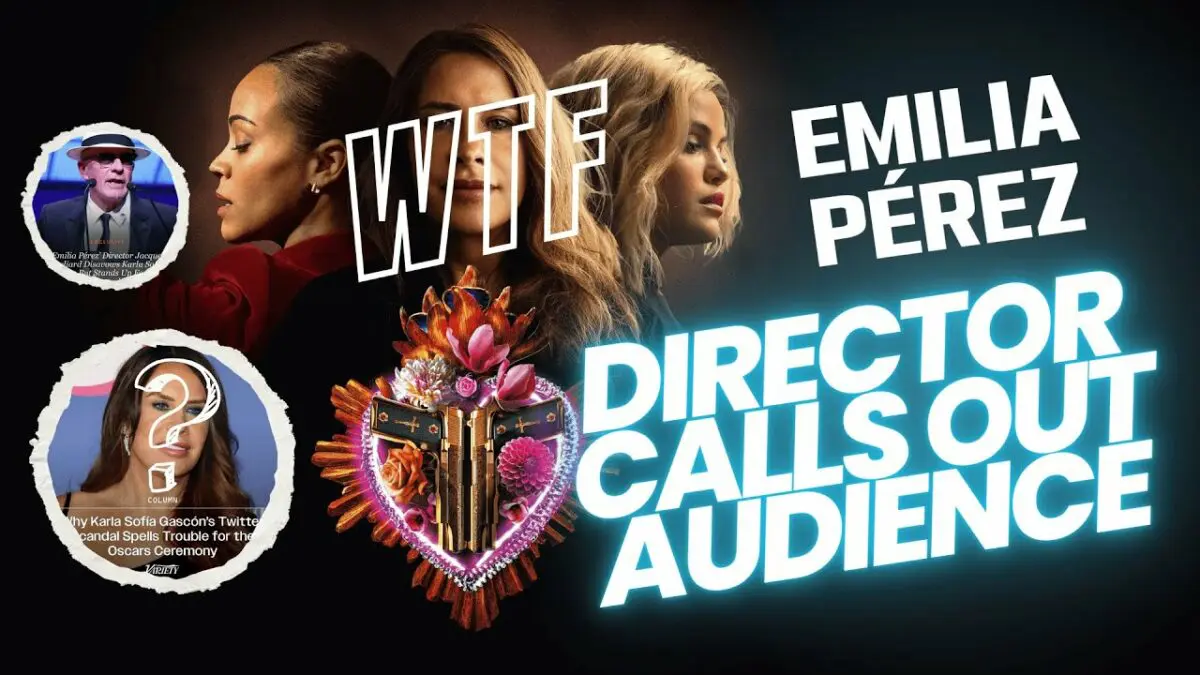In the vibrant world of cinema, few films have generated as much buzz as Emilia Pérez. This unique film, directed by Jacques Audiard, is not only pushing boundaries but is also at the heart of a torrent of discussions regarding representation and cultural portrayal. Debuting amidst a flurry of accolades, including a record-setting 13 Oscar nominations, it became a lightning rod for both praise and criticism, stirring more than just curiosity among audiences and critics alike.
The debate surrounding Emilia Pérez touches on crucial topics, allowing for a broader dialogue about the significance of representation in film. Icons like Zoe Saldaña, who portrays Rita Moro Castro, add layers to an already complex narrative. The way the film navigates its portrayal of transgender issues and cultural elements has resonated deeply, either inspiring significantly or condemning it as superficial.
As it prepares for its anticipated awards season, the film’s journey illustrates a stark juxtaposition between recognition by prestigious bodies like the Oscars and backlash from vocal segments of the audience. This dichotomy is emblematic of a changing landscape in which digital voices can echo loudly and reshape narratives.
Controversial Foundations: A Closer Look at the Film’s Premise

Emilia Pérez is billed as a musical that captures the essence of contemporary Mexico through its engaging storytelling and exuberant musical numbers. However, the film has drawn its fair share of scrutiny regarding its handling of sensitive cultural themes. With the protagonist being a transgender woman, the film’s portrayal is both a celebration and a source of contention.
Critics argue that while it aims to shed light on vital narratives, the execution often veers into territories deemed problematic. There’s a palpable sense that the film is straddling the line between appreciation and tokenization, a notion that’s ignited debates across various platforms.
The discussion around Karla Sofía Gascón, the trailblazing actress who portrays the lead role, adds another layer of complexity. Her prominence as the first transgender performer nominated for an acting Oscar invites reflections on the ongoing fight for representation in Hollywood, yet it simultaneously raises questions about the narrative built around her character.
The Musical Elements and Their Impact
The musical backdrop of Emilia Pérez is essential to understanding its appeal and challenges. The film integrates lively musical numbers that do more than entertain; they serve to explore deeper themes within the narrative. Yet, while celebrating diverse musical styles, some argue that it glosses over significant cultural nuances, risking an oversimplification of complex truths.
One of the film’s standout performances is undoubtedly a scene featuring a dynamic duet that captures the essence of the struggles faced by its characters. This mixture of artistry and storytelling attempts to marry entertainment with meaning, a feat that not all critics feel it achieved as successfully as it could have. Some segments of viewers appreciate the choreographic brilliance while others feel it detracts from the more challenging aspects of the story.
Oscars Reaction: The Duality of Praise and Backlash

The polarizing reception of Emilia Pérez can be encapsulated in its Oscar nominations. Garnering acclaim from the Academy—with accolades including Best Picture and Best Actress nominations—while simultaneously facing a backlash on social media platforms, it showcases the duality inherent in modern cinematic narratives.
Following its acknowledgments, the film’s journey faced turbulence, especially in the wake of social media scrutiny. The emergence of controversial tweets attributed to Karla Sofía Gascón stoked the flames of debate, as audiences dissected the relevance of their past actions in relation to their current stature in Hollywood. The intricacies of fame, influence, and accountability are laid bare in this ongoing discourse.
As the Oscar season unfolds, Emilia Pérez finds itself at the nexus of celebrations marking its achievements and the dissent voices that question its integrity. This scenario is reflective of broader societal dialogues regarding diversity, representation, and the responsibility that comes with storytelling.
The Crossover of Digital Media and Cinema
In an age where social media shapes public perception, Emilia Pérez serves as a landmark case study in the intersecting paths of cinema and digital discourse. Post-release, it became a focal point on platforms like Twitter and Instagram, allowing audiences to express their sentiments about portrayal, representation, and the film’s cultural impact.
The immense power of audience feedback in the digital era cannot be understated. Hashtags rallying in support or against the film allow viewers to voice their identities and beliefs, which in turn reverberates within the industry. The conversations sparked by the film highlight a more collaborative dialogue where audiences are not merely receivers but players actively participating in the narrative construction.
As debates circulate around its themes and portrayal, the discourse surrounding Emilia Pérez emphasizes a vital sentiment—stakeholders in storytelling must be equipped to engage recipients in a meaningful manner, honoring both the narratives shared and the communities represented.
International Reception: A Global Perspective

The international response to Emilia Pérez further complicates its narrative, with differing views shaped by cultural contexts. Debuting in multiple countries, the film has sparked diverse reactions, from overwhelming praise to significant backlash. It’s this global tapestry of opinion that shapes the film’s enduring legacy.
In the United States, its recognition at awards shows contributes to a narrative of success. Stil, in Mexico, the film’s portrayal of local culture and trans issues has drawn criticism for being perceived as superficial. Critics assert that it glosses over important elements that resonate deeply with the country’s history and societal context.
The digital age has allowed for instantaneous dialogues, enabling a quick turnaround in reactions that sometimes diverge sharply from critical acclaim. This disconnect can affect a film’s legacy long after it has left the box office. As Europe and Latin America grapple with their interpretations of Emilia Pérez, it underscores the importance of viewing cinema through a more nuanced, culturally sensitive lens.
Community Responses and The Power of Voice
As audiences mobilize in response to Emilia Pérez, community reactions have surfaced, illustrating the film’s impact on cultural conversations. Activist groups and social justice advocates utilize their platforms to dissect and discuss the implications of representation in the film, fostering a collective response that goes beyond mere critique.
This is where digital platforms play a pivotal role, uniting voices from across the globe and galvanizing support for marginalized communities. Engaging in thoughtful dialogues, communities can raise awareness about the importance of authentic representation, leveraging their platforms to advocate for sensitivity in storytelling.
As the film continues to screen in various locales, its ability to stimulate discourse signifies a turning point in how stories can shape collective understanding. The implications of engaging authentically with diverse narratives can be seen as a pathway toward greater inclusivity in future cinematic endeavors.
The Legacy of Emilia Pérez: What’s Next?

As Emilia Pérez solidifies its place within cinematic history, it sparks reflections on the future of storytelling. The film’s complex journey illuminates significant themes surrounding accountability, authenticity, and the responsibility of storytellers to their audiences. With ongoing discussions highlighting both its merits and its flaws, its legacy will resonate in the years to come.
The conversations initiated by the film may serve as a precipitant for change in Hollywood, influencing how representation is approached in future projects. The industry may begin to recognize that authentic storytelling requires deeper engagement, moving beyond surface-level narratives in favor of more profound, nuanced explorations that pay homage to diverse voices.
As viewers and creators alike push for more complex storytelling arcs that center marginalized experiences, Emilia Pérez may well be seen as a catalyst for a new wave of inclusive narratives. The future of cinema could very well hinge on how the industry responds to the call for integrity, accountability, and authentic representation in storytelling.
Final Thoughts on Emilia Pérez and Its Impact
The cultural resonance of Emilia Pérez continues to define its legacy as audiences navigate its achievements and critiques. The ongoing dialogues reveal a significant evolution in audience expectations, signaling a demand for authenticity in future cinematic narratives.
As cinematic landscapes shift, the lessons gleaned from this film advocate for a more virtuous and conscientious approach toward storytelling—a necessity for both creators and consumers. The intersection of film and digital discourse will undoubtedly continue to evolve, shaping the narratives of tomorrow.
Source: www.nytimes.com
Hi, I’m Sarah, a 30-year-old journalist with a passion for storytelling and uncovering the truth. I strive to bring important issues to light and connect with my audience through compelling narratives.



